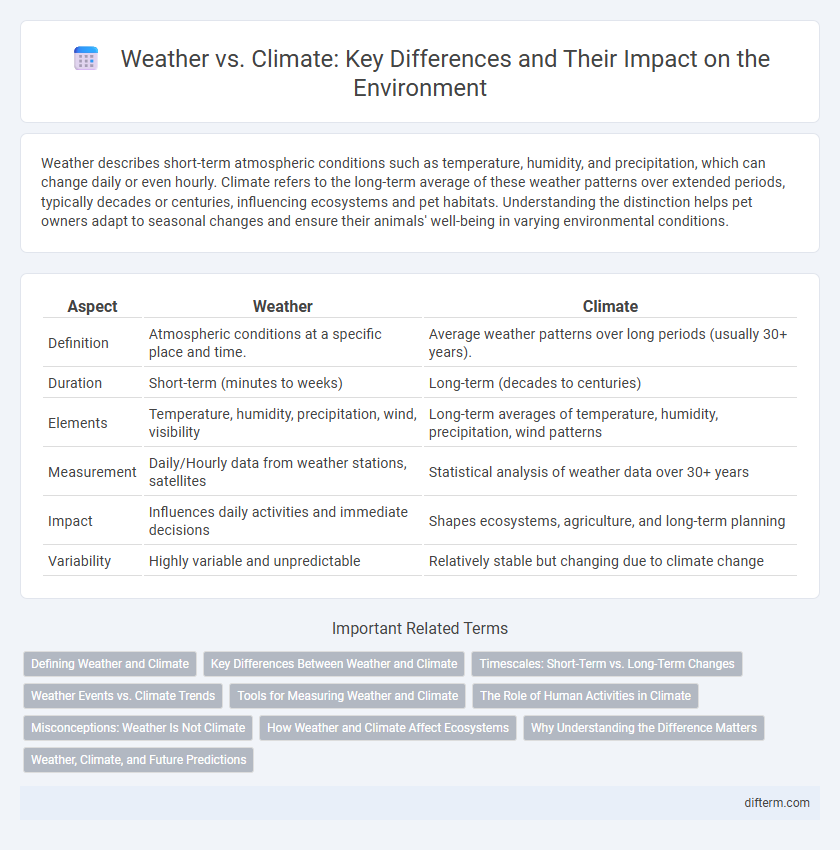Weather describes short-term atmospheric conditions such as temperature, humidity, and precipitation, which can change daily or even hourly. Climate refers to the long-term average of these weather patterns over extended periods, typically decades or centuries, influencing ecosystems and pet habitats. Understanding the distinction helps pet owners adapt to seasonal changes and ensure their animals' well-being in varying environmental conditions.
Table of Comparison
| Aspect | Weather | Climate |
|---|---|---|
| Definition | Atmospheric conditions at a specific place and time. | Average weather patterns over long periods (usually 30+ years). |
| Duration | Short-term (minutes to weeks) | Long-term (decades to centuries) |
| Elements | Temperature, humidity, precipitation, wind, visibility | Long-term averages of temperature, humidity, precipitation, wind patterns |
| Measurement | Daily/Hourly data from weather stations, satellites | Statistical analysis of weather data over 30+ years |
| Impact | Influences daily activities and immediate decisions | Shapes ecosystems, agriculture, and long-term planning |
| Variability | Highly variable and unpredictable | Relatively stable but changing due to climate change |
Defining Weather and Climate
Weather refers to the short-term atmospheric conditions, including temperature, humidity, precipitation, wind speed, and visibility, experienced in a specific location over hours or days. Climate describes the long-term patterns and averages of these weather conditions, typically assessed over 30 years or more, providing a comprehensive view of a region's typical atmospheric behavior. Understanding the distinction between weather and climate is crucial for analyzing environmental changes and predicting future climate trends.
Key Differences Between Weather and Climate
Weather refers to short-term atmospheric conditions in a specific place, including temperature, humidity, precipitation, wind, and visibility, typically observed over minutes to weeks. Climate represents the long-term average of weather patterns in a region, usually calculated over 30 years or more, encompassing trends and variability in temperature, rainfall, and extreme weather events. Key differences lie in the temporal scale and predictability: weather changes rapidly and is localized, while climate provides a broader, more stable view of environmental conditions essential for understanding global warming and ecosystem adaptation.
Timescales: Short-Term vs. Long-Term Changes
Weather represents short-term atmospheric conditions such as temperature, humidity, and precipitation that can change within minutes or days. Climate refers to long-term patterns and averages of weather over decades to centuries, indicating enduring trends rather than daily fluctuations. Understanding the difference in timescales is crucial for studying environmental changes and predicting future impacts of global warming.
Weather Events vs. Climate Trends
Weather events refer to short-term atmospheric conditions such as storms, heatwaves, and rainfall occurring over hours or days, while climate trends describe long-term patterns and averages of temperature, precipitation, and other meteorological variables over decades or centuries. Understanding the distinction between these two is crucial for analyzing the frequency and intensity of extreme weather events within the broader context of shifting climate baselines. Climate trends provide insight into systemic changes driven by factors like greenhouse gas emissions, whereas weather events illustrate immediate and localized atmospheric phenomena.
Tools for Measuring Weather and Climate
Weather is measured using tools such as thermometers for temperature, barometers for atmospheric pressure, anemometers for wind speed, and rain gauges for precipitation, providing real-time data. Climate is studied through long-term data collection using satellite observations, weather stations, and climate models that analyze historical weather patterns over decades or centuries. Advanced technologies like remote sensing and global positioning systems enhance the accuracy of both weather forecasts and climate predictions.
The Role of Human Activities in Climate
Human activities significantly influence climate through the emission of greenhouse gases such as carbon dioxide, methane, and nitrous oxide, which trap heat in the Earth's atmosphere and lead to global warming. Industrial processes, deforestation, and fossil fuel consumption accelerate climate change by altering natural carbon cycles and increasing atmospheric concentrations of these gases. This anthropogenic impact disrupts long-term climate patterns, distinguishing climate change from short-term weather variability.
Misconceptions: Weather Is Not Climate
Weather represents short-term atmospheric conditions such as temperature, humidity, and precipitation over minutes or days, while climate describes long-term patterns and averages spanning decades or centuries. Misconceptions arise when people confuse a few cold or hot days with climate trends, ignoring the broader data necessary to assess climate change accurately. Scientific consensus relies on extensive climate data sets rather than isolated weather events to understand global warming and environmental shifts.
How Weather and Climate Affect Ecosystems
Weather impacts ecosystems through short-term changes like storms or temperature fluctuations that influence animal behavior and plant growth cycles, while climate shapes long-term ecosystem structure by determining species distributions and habitat stability. Extreme weather events can cause immediate disruptions such as flooding or drought, affecting food availability and breeding patterns. Long-term climate trends influence biodiversity, ecosystem productivity, and resilience by altering precipitation patterns and temperature norms essential to ecosystem health.
Why Understanding the Difference Matters
Understanding the difference between weather and climate is essential for accurate environmental planning and risk management. Weather describes short-term atmospheric conditions, while climate reflects long-term patterns over decades, influencing ecosystem stability and resource availability. Recognizing this distinction helps policymakers implement effective strategies to address climate change and mitigate extreme weather impacts.
Weather, Climate, and Future Predictions
Weather refers to the short-term atmospheric conditions such as temperature, humidity, and precipitation experienced daily in a specific location, whereas climate describes long-term patterns and averages over decades. Accurate weather forecasting relies on real-time data from satellites, weather stations, and radar systems to predict conditions like storms or heatwaves within days or hours. Future predictions involve integrating climate models with weather data to anticipate shifts in extreme weather events due to global warming and guide adaptation strategies.
weather vs climate Infographic

 difterm.com
difterm.com